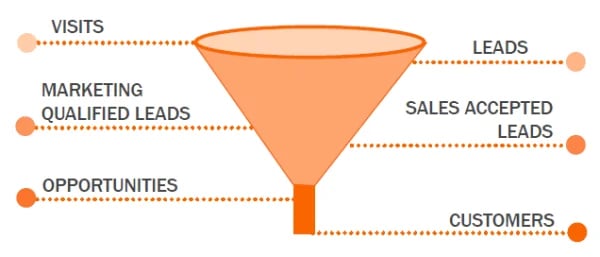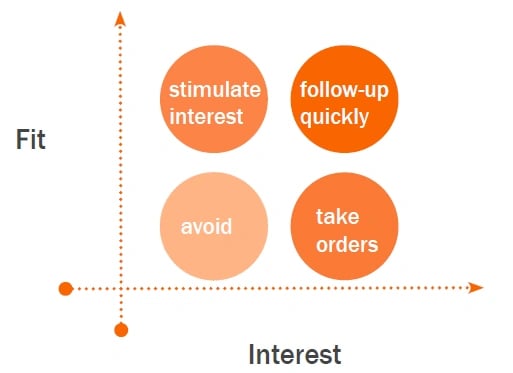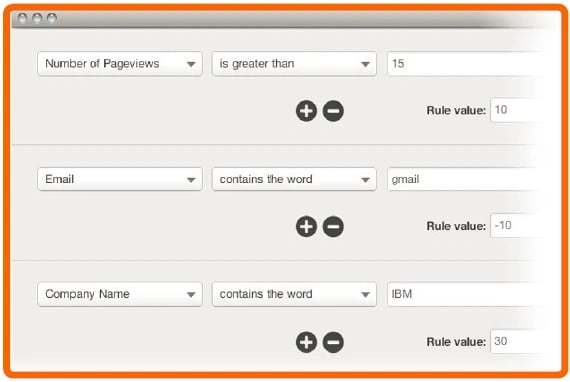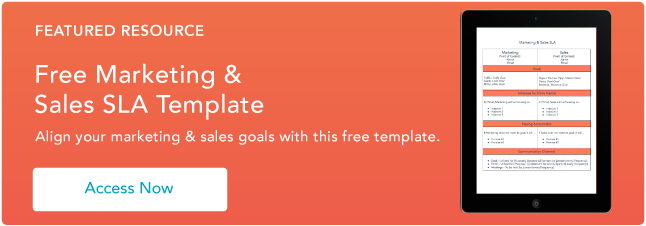By now, most marketers understand the importance of mending the traditional rift between sales and marketing. The mistrust and miscommunication that’s so often found between the two teams can act like an anchor on your company’s growth rate. In fact, organizations with good alignment between sales and marketing teams achieved 20% annual revenue growth in 2010, according to a study by the Aberdeen Group. By contrast, companies with poor alignment saw revenues decline by 4%.
Access Now: Sales & Marketing SLA Template
Often, one of the biggest blockers for sales and marketing alignment is the very different views each team has of the funnel. For example, they might disagree about the number of stages a lead passes through before becoming a customer. Furthermore, they often use different terminology to describe those stages. But in order to adopt an effective SMarketing (get it?) strategy, sales and marketing must have a unified picture of the funnel and standard definitions of each stage in the process. For example, HubSpot’s SMarketing team uses the following funnel stages:

But that's just our funnel ... what does yours look like? And how exactly can you make sure both teams are aligned in their definition of the funnel? Follow these steps to help define the stages of your funnel that both Sales and Marketing can agree upon and collaborate around.
Step 1: Understand Lead Quality
Focus on the definition of a Marketing Qualified Lead (MQL). This is the crucial handoff point between marketing and sales, so it’s essential that the teams agree on the terminology. Every company’s definition of an MQL will vary, but it should reflect a combination of traits and actions that indicate a lead is both a good fit for your company and ready to talk to a salesperson. Here’s one way to examine your funnel to assess lead quality and determine whether a lead is ready for sales follow-up:

Aspects of Lead Qualification
Is the lead a good fit?
Your company might target financial services companies with 5,000 or more employees, or small service businesses with fewer than 100 employees. Or, you may be only interested in manufacturing companies of a certain size. Within those categories, you also might identify individual lead profiles, such as title or job description and role in the decision-making process -- e.g., economic buyer, end user, influencer. How closely a lead aligns with your ideal customer profile will determine whether and when you hand it over to the sales team.
Is the lead interested?
A lead’s activity can reveal how close they are to a buying decision. For example, if a lead has only visited your website once, or has just begun following you on Twitter, they may be aware of your company but aren’t particularly engaged yet. A lead that requests a demo or views pricing information is showing a lot more interest.
Where a lead falls within the four quadrants of this matrix dictates the next step your marketing or sales team should take. For example:
- Good Fit & Interested: Leads in the upper right quadrant are a good fit for your company and are highly engaged with your marketing. These are hot leads that require immediate follow-up from your sales team -- usually in fewer than 24 hours.
- Good Fit But Less Interested: Leads in the upper left quadrant are a good fit for your company but don’t show a lot of interest yet. Perhaps they’ve only signed up for an email newsletter or downloaded one piece of educational content. These are leads that the marketing team needs to nurture.
- Lots of Interest, But Not a Good Fit: Leads in the lower right don’t necessarily fit your ideal customer profile, but are highly engaged with your brand. They might have subscribed to your blog and email newsletter, downloaded your ebooks, and attended your webinars. It’s worth having a sales rep do a low-cost follow-up with these fans to see if there’s an easy sale to make from a non-traditional customer. Sometimes leads that don’t seem like a fit have a good reason to buy your product. They can also turn into great evangelists for your products or services, thus providing you with indirect support as non-customers. That’s why you can’t automate the entire sales and marketing process. At some point, a good marketer or sales rep can spot an opportunity that your systems might overlook.
- Little Interest & No Fit: Leads in the lower left quadrant aren’t a good fit for your company and haven’t shown much interest in your marketing content. They’re definitely not worth a sales rep’s time. Don’t be afraid to take them out of your communication stream.
Step 2: Develop Your Definition of an MQL
Using this matrix as your guide, develop an MQL definition based on the combination of fit and interest that’s right for your company. Some marketers may focus more on fit because they have a tightly defined market; other marketers may have a broad customer base and focus more on interest level. That decision depends on your business model.
MQL definitions in those two cases might look like this:
- A Focus on Fit: A contact with XYZ title or role who has filled out a landing page form and works at a financial services company in the U.S. with more than 5,000 employees.
- A Focus on Interest Level: A contact with the ABC title or role who has requested a product demonstration from a sales rep and works at any U.S.-based company.
Whichever approach you chose, base your definitions on data -- not on gut instinct. Even experienced marketers and salespeople can be way off base in their assumptions about what makes a good lead.
Step 3: Implement Lead Scoring
Using a lead scoring or lead grading program that relies on data from your closed-loop analysis can help you determine the importance of different activities. Here is an example of what lead scoring can look like for you:

Here's how to implement a lead scoring system:
Examine Behavioral History
Examine the activity history of recent customers and analyze how many actions they took before becoming a customer -- i.e., the number of page views or number of conversions, such as downloading a report or registering for a webinar, etc.
Identify Patterns
Look for patters that indicate a lead’s likelihood of closing. For example, if a lead that downloads ten pieces of content from your website or visits your site more than 15 times in one month, she is more likely to close. Consider incorporating frequency measures into your MQL definition.
List Activities
Also, list all the activities that a lead can take before becoming a customer, and analyze the close rate for each one. For example, to determine the close rate for a webinar, look at all customers that had watched a webinar, then divide that number by the total number of leads that originally registered for the webinar. That gives you the close rate for leads from that
particular event.
Calculate Average Close Rates
Using the close rates for individual actions, calculate the average close rate for all your marketing activities. Then look for actions that have a significantly higher close rate. For example, if your average close rate is around 1%, you might find a handful of actions that
have a 3%-5% close rate. Add these top-closing events to your definition of an MQL. Any lead that engages in at least one of these activities, and is a good fit for your company, would be considered an MQL. Use those close rates to decide what score to give different activities in your lead scoring or lead grading system.
Step 4: Optimize the Stages of Your Sales Funnel
Now that you've identified the different stages of your sales funnel, it's important to optimize each of those stages on an ongoing basis. And that means continual analysis of key metrics at each stage of the funnel, such as:
Sales Funnel Stages
- Visitor-to-Lead Conversion Rate
- Lead-to-MQL Conversion Rate
- % Sales Accepted Leads
- Lead Work Rates
- MQL-to-Opportunity Conversion Rate
- Opportunity-to-Customer Conversion Rate
- Lead-to-Customer Conversion Rate
- Sales Cycle Length
- Average Cost Per Sale
You should be looking at these metrics all the time so you can assess whether you're slipping in any one area ... because you don't want to suffer a blip in your funnel. If your funnel develops a clog or hole somewhere along the way -- and it will, it's only natural -- you need to be able to identify it and fix it to keep your sales and marketing machine efficient. And if you are working with multiple different types of leads, these metrics should be considered for each segment of lead, too, so you know if some segments are more valuable to your business than others (or, even better, if some segments have more potential than you once realized)!
Image credit: danxoneil

Marketing and Sales Alignment
.png?width=112&height=112&name=Image%20Hackathon%20%E2%80%93%20Vertical%20(46).png)

![Service Level Agreements: 7 Steps to Writing an Effective One [+ Examples]](https://53.fs1.hubspotusercontent-na1.net/hubfs/53/service-level-agreement-1.jpg)


![The Definition of Smarketing [In Under 100 Words]](https://53.fs1.hubspotusercontent-na1.net/hub/53/file-528001045-jpg/Blog_Thinkstock_Images/yin-yang-heart.jpg)